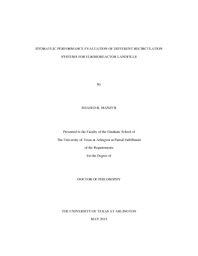| dc.description.abstract | The major aspect of bioreactor landfill is the addition of liquid and recirculation of collected leachate back into the waste mass through the subsurface Leachate Recirculation System (LRS). The leachate recirculation system consists of the perforated recirculation pipes placed inside horizontal trenches and the permeable beds with different orientation. The application of high permeability material (shredded tire chips, broken glass, pea gravel) in landfills is an emerging technology to distribute the moisture over a wider area in a shorter period of time. Horizontal or vertical perforated pipes are installed in bioreactor landfills as LRS with an expectation of uniform moisture distribution within waste to optimize the performance of bioreactor landfill.However, high heterogeneity, variability and anisotropy of MSW and the different compaction energy used in landfill may dominate the flow pattern inside the waste mass that may result variable moisture level inside landfills. In addition, moisture has a tendency to follow the preferential channels to reach the leachate collection system that even complicates to attain a uniform moisture distribution throughout the landfill. Therefore, attaining uniform moisture level for microbial activity becomes a challenge in bioreactor landfill operation. A series of Resistivity Imaging tests (RI) were performed to investigate the performance of recirculation pipes placed (1) directly on waste, (2) inside a trench with shredded tire bedding and (3) on top of permeable blankets at the City of Denton landfill. The experimental results indicated that the resistivity of the solid waste decreased with the addition of water/leachate through the horizontal trench. It was also observed from the RI test results that leachate flow along pipe is non-uniform throughout the pipe. The non-uniformity of leachate flow confirms that the flow of leachate through waste is mostly through preferential flow paths due the heterogeneous nature of the waste. The RI profiles from the baseline, recirculation and monitoring results at east, middle and west test sections indicate that resistivity decreases immediately after addition of water/ leachateHowever, the resistivity increases upto its original level after two weeks of recirculation at all locations. Therefore, based on the initial decrease and subsequent rebound of resistivity, the frequency of recirculation may be recommended bi-weekly basis to maintain a threshold moisture level inside the waste pack. It was also observed that moisture distribution is better when the recirculation pipe is placed on horizontal trench with tire chip as bedding materials. For the performance of permeable bed (tire chip bedding), temperature sensors were installed at middle and two sides of waste pack. Based on the resistivity and temperature variation results, it was observed that moisture was not traveling all the way to the sides of the waste pack and was flowing down only through the middle of the permeable tire chip materials. The subsidence results during the monitoring period indicate the subsidence of the waste mass to be around 2 ft to 3 ft. More settlement was observed at locations where more water or leachate was added. Therefore, higher settlement was observed near H2, compared to H16, H22, and H26. This directly co-relates to the percentage decrease in resistivity due to moisture or leachate addition. | en_US |

